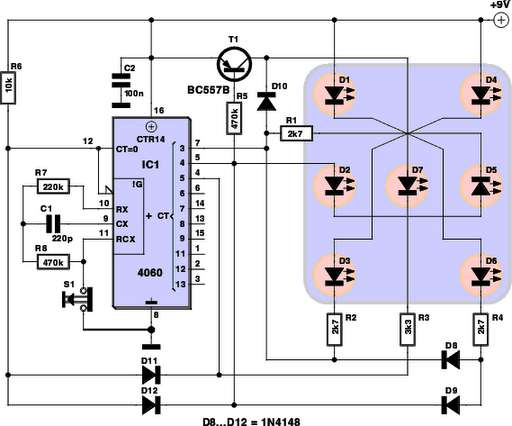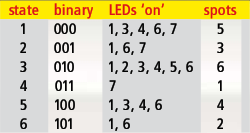Home » Circuits
Dicing With LED's
Every self-respecting DIYer makes his own electronic dice with LEDs as spots. Then you don’t have to throw the dice anymore – just push the button. The electronics also ensures that nobody can try to improve his luck by fiddling with the dice. Too bad for sore losers! This circuit proves that an electronic die built using standard components can be made quite compact. The key component of here is a type 4060 digital counter (IC1).This IC has an integrated oscillator stage, so only two resistors (R7 and R8) and a capacitor (C7) are necessary to generate the clock signal. The clock signal is divided by various factors by the internal digital circuitry of the IC. The division factors are designated by ‘CT’ in the IC drawing symbol. For instance, the signal on the CT3 output (pin 7) is a square wave with a frequency equal to the clock frequency divided by 23 (8). The clock signal is divided by 24 (16) on the CT4 output, by 25 (32) on the CT5 output, and so on. This means the output signals form a binary number that Dicing with LEDs counts upwards, which is naturally what a counter does.
Circuit diagram:
Of course, a die has only six possible values marked on the six sides of a cube. This means that at least three bits (the first three outputs) of the counter are necessary to drive a display. Eight different counter states (23) can be represented with three bits, but in this case the counter must be restricted to six states. To make sure this happens, D11, D12 and R6 are used to reset the counter to its initial state when it reaches the seventh state, which means when it reaches a binary count of 110. When this happens, pins 4 and 5 of the IC are both logic ‘1’ (high level), which causes a logic ‘1’ to be applied to pin 12 via resistor R6. This causes the counter to be reset, which is what we want.
The display consists of seven LEDs arranged in the same pattern as the usual markings on a normal die. This arrangement is shown in the schematic diagram. Before you begin thinking about the proper logical connections between the LEDs and the counter outputs, you can start by noting that except for the ‘1’ state there will always be two LEDs lit up at the same time. This means that only four distinct indications are necessary, instead of seven (with a total of seven LEDs).
Another advantage of this is that the current consumption can be reduced by connecting pairs of LEDs in series. Resistors R1–R4 limit the current through the LEDs to approximately 2 mA. This means you have to use low-current LEDs. They are nice and bright at a current of 2 mA. Resistor R3 has a higher value because only one LED is driven via it. For convenience, the circuit is dimensioned based on using a 9-V battery. The current consumption of the circuit depends on the number of LEDs that are illuminated, and with our prototype it varied over a range of approximately 2.5 mA to 6.5 mA.
The LEDs still produce enough light even when the supply voltage is as low as 6 V, but this depends strongly on the characteristics of the low-current LEDs used in the circuit. Diodes D8–D10 and transistor T1 are necessary to enable all the states of a normal die to be shown. By that, we primarily mean the states with two or three spots, which must be located diagonally. For readers who want to delve more deeply into the design, the following table shows the six different binary states, which LEDs are lit up for each state, and the number of spots shown by the die.
The die is operated by switch S1. In the quiescent state, the break contact of S1 is closed and the oscillator is stopped because the input of the oscillator stage is connected to ground via the switch. When S1 is pressed, the oscillator starts running and causes the states of the LEDs to change at a rate of 1 kHz, which is too fast to follow with the naked eye. This high frequency ensures that the state of the die is purely random when S1 is released, so there is no regularity or pattern in the results.
The circuit can be assembled on a small piece of perforated prototyping board. Fit the LEDs in exactly the same pattern as shown in the schematic diagram, since otherwise the spot patterns will not correspond to a real die. When you have assembled the circuit board, fit it in a plastic enclosure along with a 9-V battery to provide power.
Source: Elektor Electronics 12-2006


